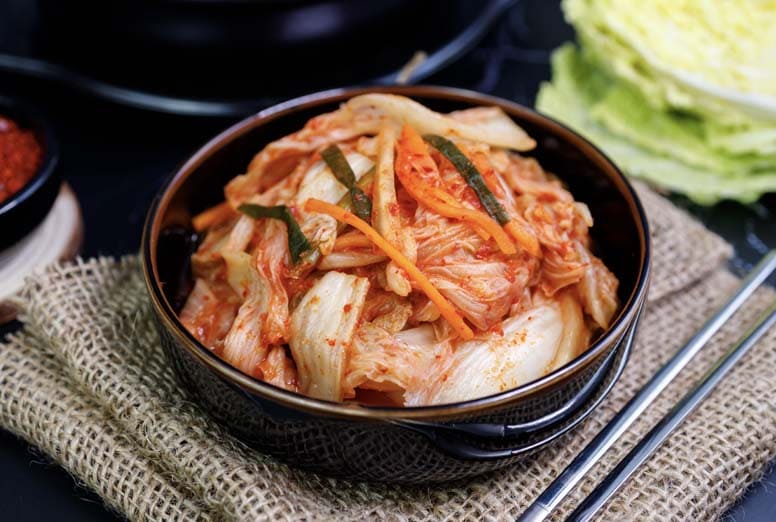Korean Kimchi Guide – Types, Pairings, and How to Eat It Right

If there’s one dish that defines Korean cuisine, it’s kimchi.
This Korean kimchi guide explores its most popular types, best food pairings, and how to enjoy it the right way.
Kimchi isn’t just a side dish — it’s a reflection of Korea’s seasons, traditions, and food culture.
What Exactly Is Kimchi?
Kimchi is a traditional Korean fermented food made by salting vegetables and seasoning them with red pepper flakes, garlic, ginger, and salted seafood.
During fermentation, lactic acid bacteria form, giving kimchi its unique tangy and umami-rich flavor.
There are about 200 to 300 different types of kimchi across Korea, shaped by local ingredients and regional climates.
Popular Types You Should Try
1. Baechu Kimchi (Napa Cabbage Kimchi)
This is the most iconic type of kimchi found in nearly every Korean home.
Depending on its fermentation level, the taste changes from crisp and mild to deep and sour.
Slightly aged kimchi adds rich flavor to kimchi stew or fried rice, and it pairs perfectly with ramen.
2. Kkakdugi (Cubed Radish Kimchi)
Made with diced Korean radish, kkakdugi is crunchy, juicy, and refreshing.
It balances the richness of soups like seolleongtang (beef bone soup) or galbitang (short rib soup) beautifully.
3. Baek Kimchi (White Kimchi)
Unlike red kimchi, baek kimchi is made without chili powder.
Its clean, mild taste complements dishes like pancakes (jeon) or grilled fish, and it’s ideal for those who prefer non-spicy food.
4. Yeolmu Kimchi (Young Radish Kimchi)
A summer staple made with young radishes.
It’s slightly spicy yet refreshing and goes perfectly with barley rice or cold noodles.
The chilled broth helps cool you down on hot summer days.
5. Dongchimi (Water Kimchi)
This clear and mild kimchi is made by soaking radish, pear, garlic, and ginger in saltwater.
It’s perfect for winter and pairs well with cold noodles (naengmyeon) or boiled pork slices (suyuk).
Its light broth also serves as a popular noodle base in Korea.
6. Pa Kimchi (Green Onion Kimchi)
Made from green onions, this kimchi has a bold aroma and spicy kick.
It goes well with bulgogi, spicy pork stir-fry, grilled ribs, and even instant black bean noodles (jajang ramyeon).
7. Buchu Kimchi (Chive Kimchi)
Light and aromatic, buchu kimchi ferments quickly and pairs wonderfully with seafood pancakes or stir-fried squid.
8. Gat Kimchi (Mustard Leaf Kimchi)
Known for its strong, sharp flavor, gat kimchi is popular in southern Korea.
It complements hearty soups like gamjatang (pork and potato stew) or pork soup (dwaeji-gukbap).
9. Chonggak Kimchi (Ponytail Radish Kimchi)
Made with small whole radishes, this kimchi is crunchy and slightly spicy.
It pairs well with boiled pork (bossam), bibim noodles, and spicy stir-fried pork.
Best Pairings for Each Type
| Type of Kimchi | Main Flavor | Best Pairings | Why It Works |
|---|---|---|---|
| Baechu Kimchi | Spicy and tangy, varies by fermentation | Samgyeopsal, kimchi stew, fried rice, ramen | Balances fatty dishes and deepens the flavor of soups. |
| Kkakdugi | Crunchy, juicy, slightly spicy | Seolleongtang, galbitang | Adds texture and cuts through rich broths. |
| Baek Kimchi | Mild and refreshing | Jeon (Korean pancakes), grilled fish | Keeps the palate clean between bites. |
| Yeolmu Kimchi | Cool and slightly spicy | Barley rice, cold noodles | Refreshes appetite in hot weather. |
| Dongchimi | Clear, mildly salty-sour broth | Naengmyeon, makguksu, suyuk | Lightens heavy flavors with its crisp finish. |
| Pa Kimchi | Strong, spicy aroma | Bulgogi, spicy pork, jajang ramyeon | The heat enhances sweet and savory dishes. |
| Buchu Kimchi | Fragrant and herbal | Seafood pancakes, stir-fried squid | Enhances the umami in seafood. |
| Gat Kimchi | Pungent and bold | Gamjatang, pork soup, sundae soup | Balances hearty, fatty broths. |
| Chonggak Kimchi | Crunchy and peppery | Bossam, bibim noodles, spicy pork | Adds freshness and texture to meaty meals. |
Tips to Enjoy It Best
1. Match by Fermentation Level
- Fresh kimchi: best eaten raw for its crispness and mild spice.
- Aged kimchi: great for stews, pancakes, or fried rice — the acidity adds richness.
2. Store It the Right Way
Kimchi ferments best at 0–5°C (32–41°F).
Too cold slows fermentation; too warm makes it overly sour.
That’s why most Korean homes have a kimchi refrigerator — a special appliance that maintains the ideal temperature year-round.
It’s so common that many people call it “another dining table in the kitchen.”
3. Balance with the Right Dishes
Spicy kimchi works with mild dishes, while tangy ones go well with fatty or savory foods.
Choosing the right kimchi type for your meal makes all the difference.
Different Regional Styles
- Jeolla Province: Rich and full of seafood-based seasoning.
- Gyeongsang Province: Saltier and cleaner in taste.
- Gangwon Province: Uses mountain vegetables instead of seafood.
- Seoul & Gyeonggi: Mild and balanced flavor, popular nationwide.
Each reflects local climate, produce, and culture — making kimchi a true symbol of Korean diversity.

How Kimchi Went Global
Kimchi has become a global symbol of K-food and is loved worldwide for its health benefits.
It’s rich in probiotics, vitamins, and minerals, promoting gut health and immunity.
You can find kimchi in supermarkets around the world — a sign that Korean food culture has truly gone global.
Final Thoughts
Kimchi isn’t just food; it’s an experience.
For travelers, it’s often the first taste of Korea — and the last flavor they remember.
Exploring different types of kimchi across the country is like tasting Korea’s landscape through flavor and time.
So next time you have a bite of kimchi, pause for a moment —
you might just taste the story of Korea itself.






